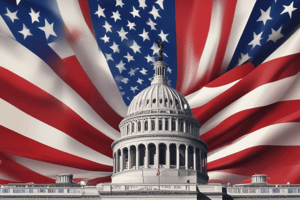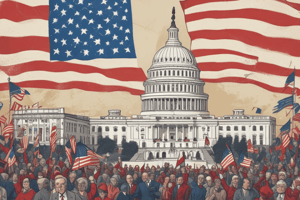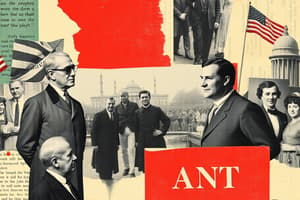Podcast
Questions and Answers
What is one of the purposes of political parties?
What is one of the purposes of political parties?
To elect like-minded individuals.
What characterized the Era of Good Feelings?
What characterized the Era of Good Feelings?
Political unity and economic prosperity.
In 1824, there was a corrupt bargain due to a lack of trust and support in the establishment.
In 1824, there was a corrupt bargain due to a lack of trust and support in the establishment.
True (A)
What event led to the creation of the Republican Party?
What event led to the creation of the Republican Party?
Which of the following describes the Modern Era of party politics (1932-present)?
Which of the following describes the Modern Era of party politics (1932-present)?
Which election is considered a critical election linked to rise of populism?
Which election is considered a critical election linked to rise of populism?
What is the role of the Chairperson in a national party?
What is the role of the Chairperson in a national party?
What happens at the National Convention concerning presidents and vice presidents?
What happens at the National Convention concerning presidents and vice presidents?
What is the purpose of 'formulating policy' in political parties?
What is the purpose of 'formulating policy' in political parties?
How is party affiliation shown generally?
How is party affiliation shown generally?
The factors that influence and shape one's beliefs are part of the process of political ______.
The factors that influence and shape one's beliefs are part of the process of political ______.
Which of the options is more conservative?
Which of the options is more conservative?
What is the focus of minor parties?
What is the focus of minor parties?
What is 'polarization' in the context of political ideas?
What is 'polarization' in the context of political ideas?
What is a consequence of increased political polarization?
What is a consequence of increased political polarization?
What do minor parties struggle to get?
What do minor parties struggle to get?
What values does the Libertarian Party support?
What values does the Libertarian Party support?
What is the major focus of the Green Party?
What is the major focus of the Green Party?
What are public opinion polls aimed at?
What are public opinion polls aimed at?
Straw polls are formal surveys.
Straw polls are formal surveys.
Flashcards
Political Parties
Political Parties
Organized groups with shared beliefs that aim to elect like-minded individuals.
Era of Good Feelings
Era of Good Feelings
A period of national unity and economic growth in the United States during the presidency of James Monroe (1817-1825).
Corrupt Bargain
Corrupt Bargain
A perceived illegitimate agreement between politicians.
Democratic Party (1828)
Democratic Party (1828)
Signup and view all the flashcards
Whig Party
Whig Party
Signup and view all the flashcards
Republican Party (1854)
Republican Party (1854)
Signup and view all the flashcards
Party Politics Era (1860-1932)
Party Politics Era (1860-1932)
Signup and view all the flashcards
Political Machines
Political Machines
Signup and view all the flashcards
The Modern Era (1932-present)
The Modern Era (1932-present)
Signup and view all the flashcards
Party Realignment
Party Realignment
Signup and view all the flashcards
Critical Elections
Critical Elections
Signup and view all the flashcards
Secular Realignment
Secular Realignment
Signup and view all the flashcards
National Party Chairperson
National Party Chairperson
Signup and view all the flashcards
DNC and RNC
DNC and RNC
Signup and view all the flashcards
National Convention
National Convention
Signup and view all the flashcards
Delegates
Delegates
Signup and view all the flashcards
Superdelegate
Superdelegate
Signup and view all the flashcards
Activities of Political Parties
Activities of Political Parties
Signup and view all the flashcards
Party Platform
Party Platform
Signup and view all the flashcards
Party Identification
Party Identification
Signup and view all the flashcards
Political Socialization
Political Socialization
Signup and view all the flashcards
Group Affiliations
Group Affiliations
Signup and view all the flashcards
Minor Parties
Minor Parties
Signup and view all the flashcards
Proportional Voting
Proportional Voting
Signup and view all the flashcards
Ranked choice voting
Ranked choice voting
Signup and view all the flashcards
Polarization
Polarization
Signup and view all the flashcards
Libertarian Party
Libertarian Party
Signup and view all the flashcards
Green Party
Green Party
Signup and view all the flashcards
Public Opinion
Public Opinion
Signup and view all the flashcards
Public Opinion Polls
Public Opinion Polls
Signup and view all the flashcards
Study Notes
- Political parties are organized groups sharing beliefs to elect like-minded individuals.
- The Era of Good Feelings was a time of political unity and economic prosperity.
- A corrupt bargain in 1824 led to a lack of trust and support in the establishment.
- This situation created the Democratic Party.
- Andrew Jackson won the 1828 election, which had more voters.
- The Democratic Party began to grow, found support in the South, and supported slavery.
- The Whig party collapsed due to competing industries of slavery and business.
- The Republican Party was created in 1852.
- The Civil War occurred in 1860.
- From 1860 to 1932, party politics saw the party being more important than the candidate.
- Clear political lines existed, with the North being Republican and the South being Democratic.
- Stability in parties came from political machines and they built loyalty and support through jobs.
The Modern Era (1932-present)
- The political process is controlled by the government through referendums, recalls, and direct election of senators.
- Candidate-led elections allow candidates to direct the party.
- Voters may ignore issues if they like the candidate.
- Suburbs experienced growth.
- Party realignment involves dramatic shifts in voting patterns and preferences.
Critical Elections
- 1800 saw one-party politics.
- 1828 marked the rise of populism.
- 1860 was defined by the Civil War/sectionalism.
- 1932 brought the Depression and the rise of "big" government.
- 1968 involved the Southern Strategy.
- 2012 saw Tea Party politics.
- Secular realignment involves smaller, local changes.
Organization of Political Parties
- Includes the National Party and state and local levels.
- The chairperson is the primary spokesperson for the party.
- The committee (DNC and RNC) oversees the convention and distributes funds.
- The national convention happens every four years to select presidents and VPs and sets the party platform.
- Delegates support the candidate who won the primary, and superdelegates are free agents.
- State and local levels of political parties include:
- State central committees
- Congressional district committees
- City and county committees
- Precinct and ward committees
- Activists and volunteers
- Voters
Activities of Political Parties
- Aim to get political power by selecting candidates, raising money, and mobilizing support.
- Parties formulate policy every four years.
- Parties organize by: Congress, Presidency, Courts and States.
- Party identification is affiliation with a political party, shown through voting.
- Political socialization includes factors that influence beliefs like parents, friends, marriage, children, job, and economic status.
Group Affiliations
- Geography (coasts are more liberal, middle America more conservative)
- Gender, race/ethnicity, age, social and economic status, religion, and marital status are affiliations.
- Minor parties focus on specific issues, proportional voting, and ranked choice voting.
- Polarization is a division that drives political ideas apart, with fewer liberal Republicans and conservative Democrats.
Polarization Causes and Consequences
- Caused by:
- Decline in good citizenship
- 24-hour news cycle/social media
- Homogenous communities
- More polarized candidates
- Clear articulation.
- Consequences of it include Less productive government, increase in biased information, lack of government integrity, and lack of strong policies.
- Minor/third parties struggle to get election traction, but they can still steal from the larger parties.
- They usually have a narrow focus and are composed of compelling candidates or ideas.
Parties
- The Libertarian party supports individual liberty and limited government through a free market, non-interference in private lives, and privatizing most services outside of foreign affairs.
- The Green Party focuses on environmental issues (green economy) such as: renewable energy, living wage, affordable housing, non-interventionism, demilitarization and sustainable society.
- Public opinion can influence parties thoughts on key issues or policy.
- Public opinion polls are: surveys or interviews aimed at determining public's stance.
- A straw poll is an informal survey to get quick feelings on issues, but it can misconstrue who is sampled, the timing of polls, and self-selection.
How to create polls
- Determine the content and phrasing; questions can be created to form bias, and push polls push people to feel a certain way.
- Sample selection involves deciding who will be asked; random sampling may not reflect the actual population, and stratified sampling divides into subgroups and weighs against national averages.
- Phone calls are used for basic, daily tracking, and protected speech.
- In-person interviewing is the most accurate and detailed method but the hardest to execute as it can create bias.
- Internet polls are the most popular and easiest but can lead to extreme results and be taken over by bots.
- Analyzing data requires breaking down information to inform decision-making.
Shortcomings of Polling
- Survey error (aka margin of error)
- Limited response choices (a good poll has 5-7)
- Lack of information (no knowledge on the topic)
- Measures intensity
- Lack of interest.
- Polls are useful because there is still good polling through random and diverse samples.
- Polls influence policy and action through competitive seats and can be used to overcome outside influences like lobbying.
Studying That Suits You
Use AI to generate personalized quizzes and flashcards to suit your learning preferences.





